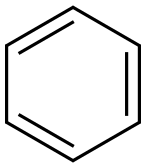1,3-Bis(trifluoromethyl)-benzene
Synonym(s):α,α,α,α′,α′,α′-Hexafluoro-m-xylene
- CAS NO.:402-31-3
- Empirical Formula: C8H4F6
- Molecular Weight: 214.11
- MDL number: MFCD00000392
- EINECS: 206-939-4
- SAFETY DATA SHEET (SDS)
- Update Date: 2024-12-18 14:08:52

What is 1,3-Bis(trifluoromethyl)-benzene?
Chemical properties
CLEAR COLOURLESS LIQUID
The Uses of 1,3-Bis(trifluoromethyl)-benzene
1,3-Bis(trifluoromethyl)benzene undergoes regioselective metalation and subsequent carboxylation at position 2 to give 2,6-bis(trifluoromethyl)benzoic acid. a convenient, selective synthesis of bis[2,4-bis(trifluoromethyl)phenyl]phosphane derivatives with 1,3-bis(trifluoromethyl)benzene as starting material.
General Description
Lithiation reaction of 1,3-bis(trifluoromethyl)benzene has been investigated. 1,3-Bis(trifluoromethyl)benzene undergoes regioselective metalation and subsequent carboxylation at position 2 to give 2,6-bis(trifluoromethyl)benzoic acid.
Properties of 1,3-Bis(trifluoromethyl)-benzene
| Melting point: | -35°C |
| Boiling point: | 116-116.3 °C(lit.) |
| Density | 1.378 g/mL at 25 °C(lit.) |
| refractive index | n |
| Flash point: | 26 °C |
| storage temp. | Sealed in dry,2-8°C |
| form | clear liquid |
| color | Colorless to Light yellow to Light orange |
| Specific Gravity | 1.378 |
| Water Solubility | Insoluble in water. Soluble in alcohol, ether, benzene. |
| BRN | 2052589 |
| Dielectric constant | 5.9800000000000004 |
| CAS DataBase Reference | 402-31-3(CAS DataBase Reference) |
| NIST Chemistry Reference | Benzene, 1,3-bis(trifluoromethyl)-(402-31-3) |
| EPA Substance Registry System | Benzene, 1,3-bis(trifluoromethyl)- (402-31-3) |
Safety information for 1,3-Bis(trifluoromethyl)-benzene
| Signal word | Warning |
| Pictogram(s) |
 Flame Flammables GHS02  Exclamation Mark Irritant GHS07  Environment GHS09 |
| GHS Hazard Statements |
H226:Flammable liquids H315:Skin corrosion/irritation H319:Serious eye damage/eye irritation H335:Specific target organ toxicity, single exposure;Respiratory tract irritation H411:Hazardous to the aquatic environment, long-term hazard |
| Precautionary Statement Codes |
P210:Keep away from heat/sparks/open flames/hot surfaces. — No smoking. P233:Keep container tightly closed. P240:Ground/bond container and receiving equipment. P273:Avoid release to the environment. P303+P361+P353:IF ON SKIN (or hair): Remove/Take off Immediately all contaminated clothing. Rinse SKIN with water/shower. P305+P351+P338:IF IN EYES: Rinse cautiously with water for several minutes. Remove contact lenses, if present and easy to do. Continuerinsing. |
Computed Descriptors for 1,3-Bis(trifluoromethyl)-benzene
| InChIKey | SJBBXFLOLUTGCW-UHFFFAOYSA-N |
New Products
(S)-3-Aminobutanenitrile hydrochloride 4-Methylphenylacetic acid N-Boc-D-alaninol N-BOC-D/L-ALANINOL Tert-butyl bis(2-chloroethyl)carbamate 3-Morpholino-1-(4-nitrophenyl)-5,6-dihydropyridin- 2(1H)-one Furan-2,5-Dicarboxylic Acid Tropic acid 1-Bromo-3,5-Di-Tert-Butylbenzene S-2-CHLORO PROPIONIC ACID ETHYL ISOCYANOACETATE 2-Bromo-1,3-Bis(Dimethylamino)Trimethinium Hexafluorophosphate 4-IODO BENZOIC ACID 3-NITRO-2-METHYL ANILINE 1-(2,4-DICHLOROPHENYL) ETHANAMINE (2-Hydroxyphenyl)acetonitrile 4-Bromopyrazole 2-(Cyanocyclohexyl)acetic acid 4-methoxy-3,5-dinitropyridine 1-(4-(aminomethyl)benzyl)urea hydrochloride 2-aminopropyl benzoate hydrochloride diethyl 2-(2-((tertbutoxycarbonyl)amino) ethyl)malonate tert-butyl 4- (ureidomethyl)benzylcarbamate Ethyl-2-chloro((4-methoxyphenyl)hydrazono)acetateRelated products of tetrahydrofuran








You may like
-
 1,3-Bis(trifluoromethyl)benzene CAS 402-31-3View Details
1,3-Bis(trifluoromethyl)benzene CAS 402-31-3View Details
402-31-3 -
 1,3-Bis(trifluoromethyl)benzene, 99% CAS 402-31-3View Details
1,3-Bis(trifluoromethyl)benzene, 99% CAS 402-31-3View Details
402-31-3 -
 1,3-Bis(trifluoromethyl)benzene CAS 402-31-3View Details
1,3-Bis(trifluoromethyl)benzene CAS 402-31-3View Details
402-31-3 -
 1975-50-4 98%View Details
1975-50-4 98%View Details
1975-50-4 -
 2-HYDROXY BENZYL ALCOHOL 98%View Details
2-HYDROXY BENZYL ALCOHOL 98%View Details
90-01-7 -
 2-Chloro-1,3-Bis(Dimethylamino)Trimethinium Hexafluorophosphate 221615-75-4 98%View Details
2-Chloro-1,3-Bis(Dimethylamino)Trimethinium Hexafluorophosphate 221615-75-4 98%View Details
221615-75-4 -
 14714-50-2 (2-Hydroxyphenyl)acetonitrile 98+View Details
14714-50-2 (2-Hydroxyphenyl)acetonitrile 98+View Details
14714-50-2 -
 118753-70-1 98+View Details
118753-70-1 98+View Details
118753-70-1
Statement: All products displayed on this website are only used for non medical purposes such as industrial applications or scientific research, and cannot be used for clinical diagnosis or treatment of humans or animals. They are not medicinal or edible.